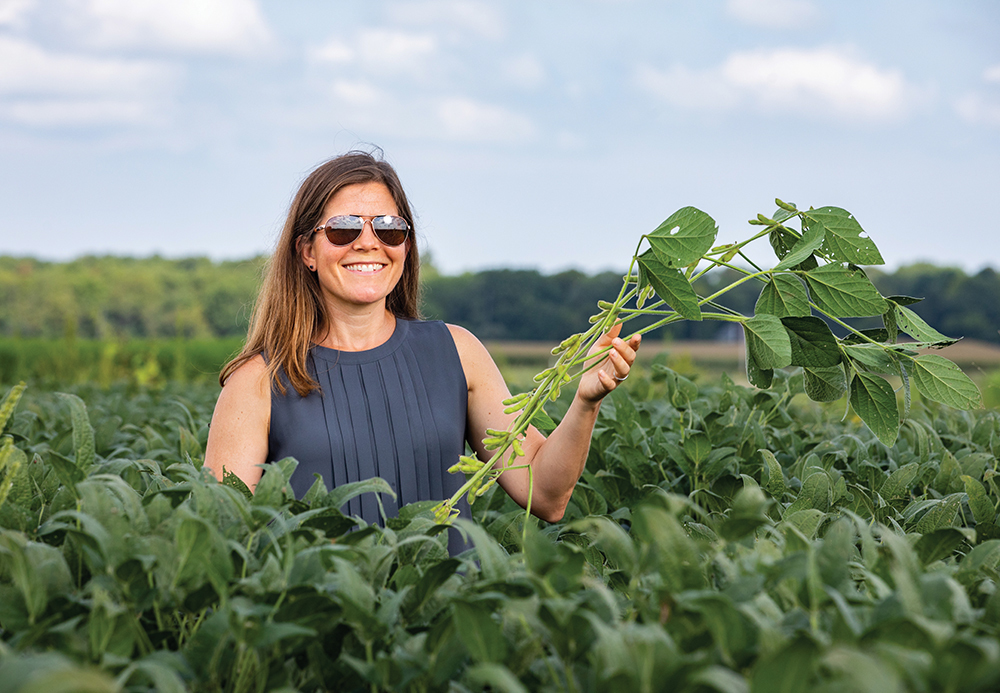For two decades, Ainsworth has helped shape climate change research at SoyFACE

Perhaps at first, it was a case of being in the right place at the right time for Lisa Ainsworth, but in the past 20-plus years, she he has left an indelible mark on the advancement of crop resilience to climate change.
In 2001, USDA Scientist Don Ort along with Steve Long and Evan DeLucia, professors in the Department of Plant Biology, built the Soybean Free Air Concentration Enrichment (SoyFACE) Center in Savoy, Ill., to demonstrate the effects of climate change on crops. Ainsworth, then a Ph.D. student in the Long lab, conducted some of the first experiments at SoyFACE.
Today Ainsworth is in her third decade as a federal scientist under the USDA Agricultural Research Service (ARS). She heads the USDA ARS Global Change & Photosynthesis Unit at SoyFACE and continues to work with the trio of founders, scientists from the University of Illinois and other institutions from around the world, and more recently the team of researchers affiliated with the Agroecosystem Sustainability Center (ASC).
“I think there is tremendous benefit in having long-term funding for mission-driven research in a location that is developing cutting-edge practices,” Ainsworth said. “We have access to all of the equipment, the talent of the university, as well our mission through ARS. I actually think it can be the best of both worlds.”

Ainsworth indicates that more than half of the USDA ARS researchers are on university campuses, which has proven mutually beneficial as an epicenter for research.
“This university is especially good at promoting, encouraging and supporting team science,” Ainsworth said. “There have been a number of these experiments around the world, but none have lasted for as long as the experiment at SoyFACE. It’s just one example of two institutions working together to do more than they could do individually.”
As a Ph.D. student, Ainsworth not only studied photosynthesis and its response to rising CO2 concentrations at SoyFACE, but also did the same with oak trees at an open-top chamber experiment at Cape Canaveral, Fla., and conducted face experiments on ryegrass and clover just outside of Zurich, Switzerland. Following a postdoc experience as a Humboldt Fellow in Germany, she returned to Illinois and has built her career at SoyFACE.
Much like ASC, SoyFACE has thrived not only through the cross-disciplinary environment at the University of Illinois, but also because it is in an area dominated by agriculture.
“Initially, Steve Long came to Illinois from the University of Essex in part to start a FACE experiment,” Ainsworth recalled. “He thought that fields in Central Illinois would be pretty homogenous and a good testbed for this pretty new approach. We have been able to ask questions from a fundamental science perspective, but also from an applied science perspective.”
The mission of the SoyFACE experiment has changed slightly over its two decades — from simply demonstrating the effects of climate change to discovering ways for crops to thrive under futuristic climate conditions, such as increased CO2 and ozone, elevated temperature, and drought. Ainsworth studies genetic variation and crop responses to these elements of climate change and has collaborated with soybean breeders, both inside and outside of ARS.
“If we can identify lines that are more tolerant to ozone and more responsive to CO2, and then understand the genetics that are underpinning those responses, we have the ability to design crops in the future that will produce more,” she said. “We are able to study those responses from molecular mechanisms up to ecosystem-level responses.”
SoyFACE also enables studies on how plant-weed interactions and plant-insect interactions might change in the future.
“Measurements of plant responses to climate change provide critical data to feed into our models of future agricultural productivity,” Ainsworth said. “Plant responses to climate change will also in part determine future atmospheric composition and future climate. SoyFACE and other FACE experiments provide ground truth data that is critical to research efforts to model the Earth’s system.”
The partnership with ASC and Founding Director Kaiyu Guan has, among other things, enhanced the modeling component to the research.
“The goal for ASC is to improve the sustainability of agriculture and that is also fundamental to the research that I do,” Ainsworth said of the partnership. “A big piece of that as we look to the future is adaptation to climate change.”
Ainsworth has worked alongside ASC to improve remote sensing for monitoring nitrogen in crops. Guan has also tested solar induced fluorescence (SIF) under different environmental conditions at SoyFACE.
ASC has brought together teams like Ainsworth’s to collectively tackle some of the grand challenges of sustainability in the 21st century and beyond.
“Kaiyu has brought people together that have very different expertise, but a similar motivation, that is the desire to improve agriculture and to adapt agriculture to climate change that is here already and is impending, and increase its sustainability,” Ainsworth said. “It’s one thing to just increase yields and maybe have more inputs, but that’s not going to help us with the state of the planet. We all understand the need for a systems-level approach to adapt to any change that we make. With Kaiyu at the helm, the sky’s the limit.”
This story was written by Mike Koon and originally published by the Agroecosystem Sustainability Center.
RELATED RIPE OBJECTIVES
Optimizing Canopies